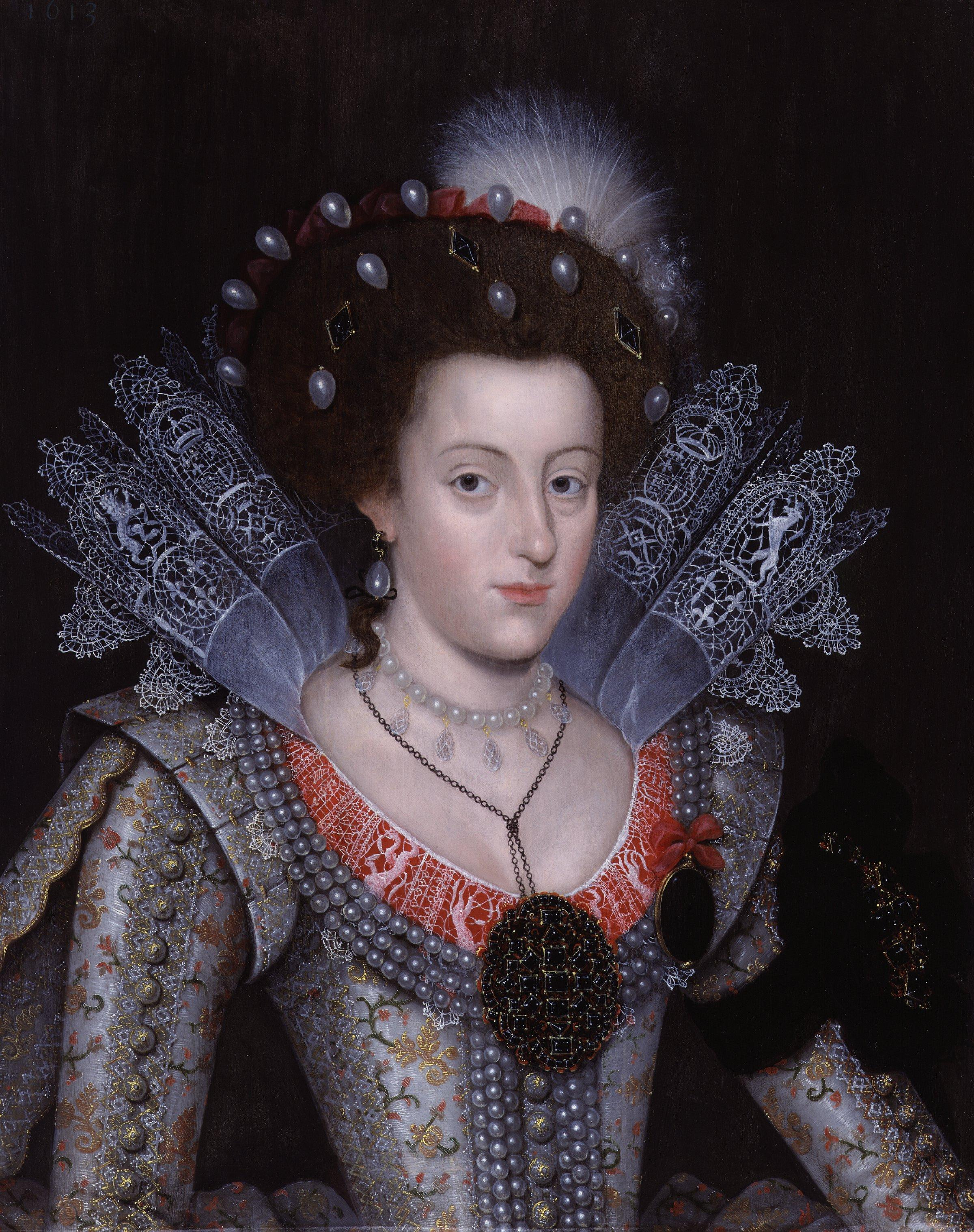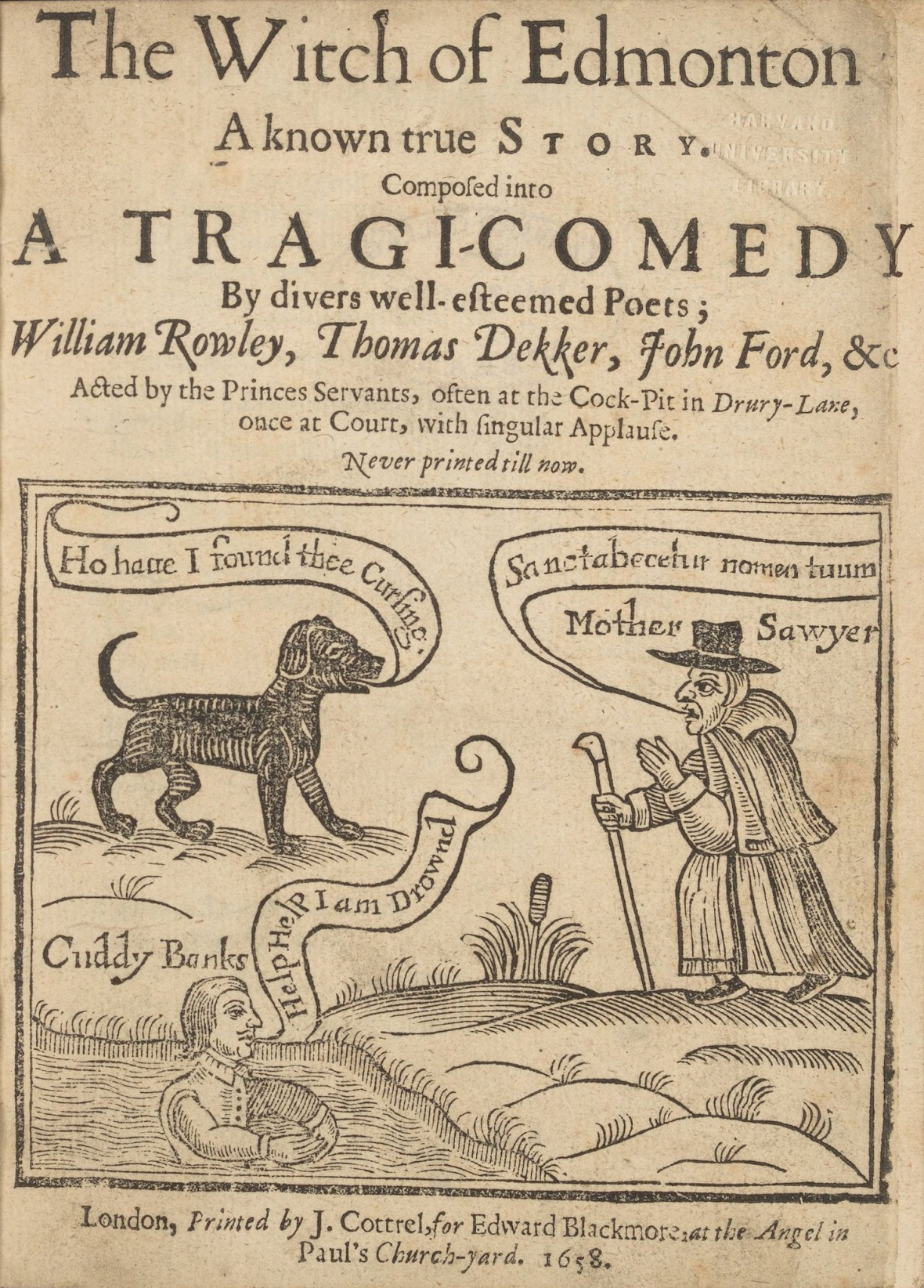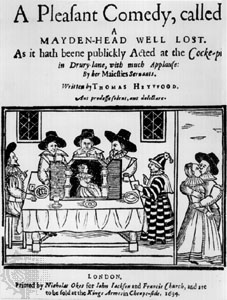|
Merry Devil Of Edmonton
''The Merry Devil of Edmonton'' is an Elizabethan-era stage play; a comedy about a magician, Peter Fabell, nicknamed the Merry Devil. It was at one point attributed to William Shakespeare, but is now considered part of the Shakespeare Apocrypha. Date and text Scholars have conjectured dates of authorship for the play as early as 1592, though most favor a date in the 1600–4 period. ''The Merry Devil'' enters the historical record in 1604, when it is mentioned in a contemporary work called the ''Black Booke''. The play was entered into the Stationers' Register on 22 October 1607, and published the next year, in a quarto printed by Henry Ballard for the bookseller Arthur Johnson (Q1 – 1608). Five more quartos appeared through the remainder of the century: Q2 – 1612; Q3 – 1617; Q4 – 1626; Q5 – 1631; and Q6 – 1655. All of these quartos were anonymous. Shakespearean authorship Publisher Humphrey Moseley obtained the rights to the play and re-registered it on 9 Septembe ... [...More Info...] [...Related Items...] OR: [Wikipedia] [Google] [Baidu] |
Comedy
Comedy is a genre of fiction that consists of discourses or works intended to be humorous or amusing by inducing laughter, especially in theatre, film, stand-up comedy, television, radio, books, or any other entertainment medium. The term originated in ancient Greece: in Athenian democracy, the public opinion of voters was influenced by political satire performed by comic poets in theaters. The theatrical genre of Greek comedy can be described as a dramatic performance pitting two groups, ages, genders, or societies against each other in an amusing '' agon'' or conflict. Northrop Frye depicted these two opposing sides as a "Society of Youth" and a "Society of the Old". A revised view characterizes the essential agon of comedy as a struggle between a relatively powerless youth and the societal conventions posing obstacles to his hopes. In this struggle, the youth then becomes constrained by his lack of social authority, and is left with little choice but to resort to ruses w ... [...More Info...] [...Related Items...] OR: [Wikipedia] [Google] [Baidu] |
Project Gutenberg
Project Gutenberg (PG) is a Virtual volunteering, volunteer effort to digitize and archive cultural works, as well as to "encourage the creation and distribution of eBooks." It was founded in 1971 by American writer Michael S. Hart and is the oldest digital library. Most of the items in its collection are the full texts of books or individual stories in the public domain. All files can be accessed for free under an open format layout, available on almost any computer. , Project Gutenberg had reached 50,000 items in its collection of free eBooks. The releases are available in Text file, plain text as well as other formats, such as HTML, PDF, EPUB, Mobipocket, MOBI, and Plucker wherever possible. Most releases are in the English language, but many non-English works are also available. There are multiple affiliated projects that provide additional content, including region- and language-specific works. Project Gutenberg is closely affiliated with Distributed Proofreaders, an Inte ... [...More Info...] [...Related Items...] OR: [Wikipedia] [Google] [Baidu] |
William Kozlenko
William Kozlenko was a playwright, screenwriter, and editor of multiple stage-play compilations and anthologies, as well as being a founding editor of ''One-Act Play Magazine'', which published from 1937–1942,''One-Act Play Magazine'' (serials catalog entry), Hathi Trust digital catalog. Retrieved 2019-10-24. and a co-founder of the One-Act Repertory Theater. Foote, Horton. ''Genesis of an American playwright'', Baylor University Press, 2004, page 104. His best-known editorial compilations include ''The Disputed Works of '' and the 1938 collection ''The Best S ... [...More Info...] [...Related Items...] OR: [Wikipedia] [Google] [Baidu] |
Edmund Kerchever Chambers
Sir Edmund Kerchever Chambers, (16 March 1866 – 21 January 1954), usually known as E. K. Chambers, was an English literary critic and Shakespearean scholar. His four-volume work on ''The Elizabethan Stage'', published in 1923, remains a standard resource. Life Chambers was born in West Ilsley, Berkshire. His father was a curate there and his mother the daughter of a Victorian theologian. He was educated at Marlborough College, before matriculating at Corpus Christi College, Oxford. He won a number of prizes, including the chancellor's prize in English for an essay on literary forgery in 1891. He took a job with the national education department, and married Eleanor Bowman in 1893. In the newly created Board of Education, Chambers worked principally to oversee adult and continuing education. He rose to be second secretary, but the work for which he is remembered took place outside the office, at least before he retired from the Board in 1926. He was the first president of ... [...More Info...] [...Related Items...] OR: [Wikipedia] [Google] [Baidu] |
Frederick V, Elector Palatine
Frederick V (german: link=no, Friedrich; 26 August 1596 – 29 November 1632) was the Elector Palatine of the Rhine in the Holy Roman Empire from 1610 to 1623, and reigned as King of Bohemia from 1619 to 1620. He was forced to abdicate both roles, and the brevity of his reign in Bohemia earned him the derisive sobriquet "the Winter King" (Czech: ''Zimní král''; German: ''Winterkönig''). Frederick was born at the hunting lodge (german: Jagdschloss) in Deinschwang, Palatinate (present-day Lauterhofen, Germany). He was the son of Frederick IV and of Louise Juliana of Orange-Nassau, the daughter of William the Silent and Charlotte de Bourbon-Montpensier. An intellectual, a mystic, and a Calvinist, he succeeded his father as Prince-Elector of the Rhenish Palatinate in 1610. He was responsible for the construction of the famous ''Hortus Palatinus'' gardens in Heidelberg. In 1618 the largely Protestant Czech nobility of Bohemia rebelled against their Catholic King Ferdinand, ... [...More Info...] [...Related Items...] OR: [Wikipedia] [Google] [Baidu] |
James VI And I
James VI and I (James Charles Stuart; 19 June 1566 – 27 March 1625) was King of Scotland as James VI from 24 July 1567 and King of England and Ireland as James I from the union of the Scottish and English crowns on 24 March 1603 until his death in 1625. The kingdoms of Scotland and England were individual sovereign states, with their own parliaments, judiciaries, and laws, though both were ruled by James in personal union. James was the son of Mary, Queen of Scots, and a great-great-grandson of Henry VII, King of England and Lord of Ireland, and thus a potential successor to all three thrones. He succeeded to the Scottish throne at the age of thirteen months, after his mother was compelled to abdicate in his favour. Four different regents governed during his minority, which ended officially in 1578, though he did not gain full control of his government until 1583. In 1603, he succeeded Elizabeth I, the last Tudor monarch of England and Ireland, who died childless. He ... [...More Info...] [...Related Items...] OR: [Wikipedia] [Google] [Baidu] |
Elizabeth Of Bohemia
Elizabeth Stuart (19 August 159613 February 1662) was Electress of the Palatinate and briefly Queen of Bohemia as the wife of Frederick V of the Palatinate. Since her husband's reign in Bohemia lasted for just one winter, she is called the Winter Queen. Elizabeth was the second child and eldest daughter of James VI and I, King of Scotland, England, and Ireland, and his wife, Anne of Denmark. With the demise of Anne, Queen of Great Britain, the last Stuart monarch in 1714, Elizabeth's grandson by her daughter Sophia of Hanover succeeded to the British throne as George I, initiating the House of Hanover. Early life Elizabeth was born at Dunfermline Palace, Fife, on 19 August 1596 at 2 o'clock in the morning. M. Barbieri, ''Descriptive and Historical Gazetteer of the Counties of Fife, Kinross, and Clackmannan'' (1857)p. 157 “ELIZABETH STUART.-Calderwood, after referring to a tumult in Edinburgh, says, that shortly before these events, the Queen (of James VI.) was delivered ... [...More Info...] [...Related Items...] OR: [Wikipedia] [Google] [Baidu] |
Wedding Of Princess Elizabeth And Frederick V Of The Palatinate
The wedding of Princess Elizabeth (1596–1662), daughter of James VI and I, and Frederick V of the Palatinate (1596–1632) was celebrated in London in February 1613. There were fireworks, masques (small, choreography-based plays), tournaments, and a mock-sea battle or naumachia. Preparations involved the construction of a "Marriage room", a hall adjacent to the 1607 Banqueting House at Whitehall Palace. The events were described in various contemporary pamphlets and letters. Arrival of the Count Palatine Frederick arrived at Gravesend on 16 October 1612. He was met by Lewes Lewknor, the master of ceremonies, and he decided to come to London by river. The Duke of Lennox brought him to the water gate of Whitehall Palace where he met Prince Charles, known as the Duke of York. He went into the newly built Banqueting Hall (or rather a new adjacent hall, the banqueting house had been built in 1607) to meet King James. They spoke in French, as it seems Elizabeth did not speak ... [...More Info...] [...Related Items...] OR: [Wikipedia] [Google] [Baidu] |
Thomas Dekker (poet)
Thomas Dekker (c. 1572 – 25 August 1632) was an English Elizabethan dramatist and pamphleteer, a versatile and prolific writer, whose career spanned several decades and brought him into contact with many of the period's most famous dramatists. Early life Little is known of Dekker's early life or origins. From references in his pamphlets, Dekker is believed to have been born in London around 1572, but nothing is known for certain about his youth. His last name suggests Dutch ancestry, and his work, some of which is translated from Latin, suggests that he attended grammar school. Career Dekker embarked on a career as a theatre writer in the middle 1590s. His handwriting is found in the manuscript of '' Sir Thomas More'', though the date of his involvement is undetermined. More certain is his work as a playwright for the Admiral's Men of Philip Henslowe, in whose account book he is first mentioned in early 1598. While there are plays connected with his name performed as early ... [...More Info...] [...Related Items...] OR: [Wikipedia] [Google] [Baidu] |
Thomas Heywood
Thomas Heywood (early 1570s – 16 August 1641) was an English playwright, actor, and author. His main contributions were to late Elizabethan and early Jacobean theatre. He is best known for his masterpiece ''A Woman Killed with Kindness'', a domestic tragedy, which was first performed in 1603 at the Rose Theatre by the Worcester's Men company. He was a prolific writer, claiming to have had "an entire hand or at least a maine finger in two hundred and twenty plays", although only a fraction of his work has survived. Early years Few details of Heywood's life have been documented with certainty. Most references indicate that the county of his birth was most likely Lincolnshire, while the year has been variously given as 1570, 1573, 1574 and 1575. It has been speculated that his father was a country parson and that he was related to the half-century-earlier dramatist John Heywood, whose death year is, again, uncertain, but indicated as having occurred not earlier than 1575 and n ... [...More Info...] [...Related Items...] OR: [Wikipedia] [Google] [Baidu] |
Michael Drayton
Michael Drayton (1563 – 23 December 1631) was an English poet who came to prominence in the Elizabethan era. He died on 23 December 1631 in London. Early life Drayton was born at Hartshill, near Nuneaton, Warwickshire, England. Almost nothing is known about his early life, beyond the fact that in 1580 he was in the service of Thomas Goodere of Collingham, Nottinghamshire. 19th- and 20th-century scholars, on the basis of scattered allusions in his poems and dedications, suggested that Drayton might have studied at the University of Oxford, and been intimate with the Polesworth branch of the Goodere family. More recent work has cast doubt on those speculations. Literary career 1590–1602 In 1590, he produced his first book, ''The Harmony of the Church'', a volume of spiritual poems, dedicated to Lady Devereux. It is notable for a version of the '' Song of Solomon'', executed with considerable richness of expression. However, with the exception of forty copies, seized by the A ... [...More Info...] [...Related Items...] OR: [Wikipedia] [Google] [Baidu] |






